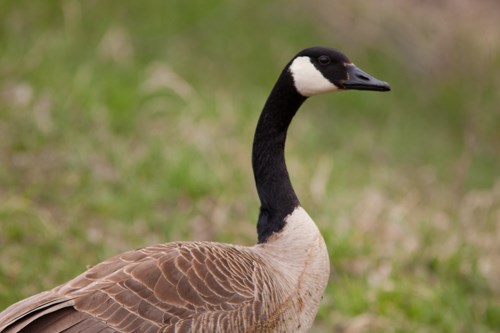
NPS/Gordon Dietzman IntroductionThis familiar bird with its loud honking calls is common throughout the Twin Cities area, including the Mississippi National River and Recreation Area. But our giant race of these handsome birds once teetered on the brink of extinction. Rare in the early 1900s, an aggressive conservation program trans-located Canada geese from areas in which they were more common to areas from which they had disappeared. Populations have recovered, but some believe that conservation efforts may have succeeded too well, as many homeowners and golfers consider Canada geese--and their droppings--to be nuisances. Canada geese feed on grass, but have inefficient digestive systems and a lot of what they eat finds its way onto our yards as droppings. Yards and golf courses offer the geese great places for grazing and our penchant for wanting to live near the water puts this food source right where geese live. This ideal combination of yards and water, from the bird’s perspective, puts them on a collision course with those that value neat yards and golf greens. Geese are long-lived birds and each pair will produce 3-8 young each year, so they can quickly become numerous in good habitat. They are also well-adapted to cold weather and often only migrate far enough south to find grass and open water. Many Canada geese are remaining year round in the Twin Cities and other northern urban areas. Control methods include hunting or moving them, but the former solution often isn't possible in urban areas and the latter solution often transfers the problem to other homeowners. Some landowners find leaving a barrier of tall vegetation (preferably one of native plantings) between water and yards reduce the problems. Plantings also reduce shoreline erosion and reduce the amount of yard fertilizers and pesticides from entering the waterbody. Bangers (that produce a shotgun report) are effective for short periods of time. Life-sized predator cutouts may also be used, but the adaptable geese quickly acclimate to both bangers and cutouts and continue their untidy ways. Despite their messy habits, what would we have lost if migrating skeins of Canada geese were absent from our autumn skies and their wild calls failed to reach our ears? Identification
Get InvolvedEven if you don't have geese in your yard, planting a buffer strip of native plants at water's edge helps preserve water quality by reducing fertilizer and pesticide runoff. For more information about shoreline protection, contact the Minnesota Department of Natural Resources. |
Last updated: April 29, 2022
